FEMS App Time-of-Use Tariff
1. Introduction
Dear customer,
Thank you for choosing the "FEMS App Time-of-Use Tariff". You are welcome to send us your suggestions so that we can further improve the quality of our products.
2. Installing the app
When you ordered the "FEMS App Time-of-Use Tariff", you received a 16-digit license key. You can use this license key to redeem the app independently in the FEMS App Center.
Find instructions on how to proceed here.
After installing the "FEMS App Time-of-Use Tariff", you still need to install the corresponding app for your electricity provider. You can find this in the FEMS App Center:
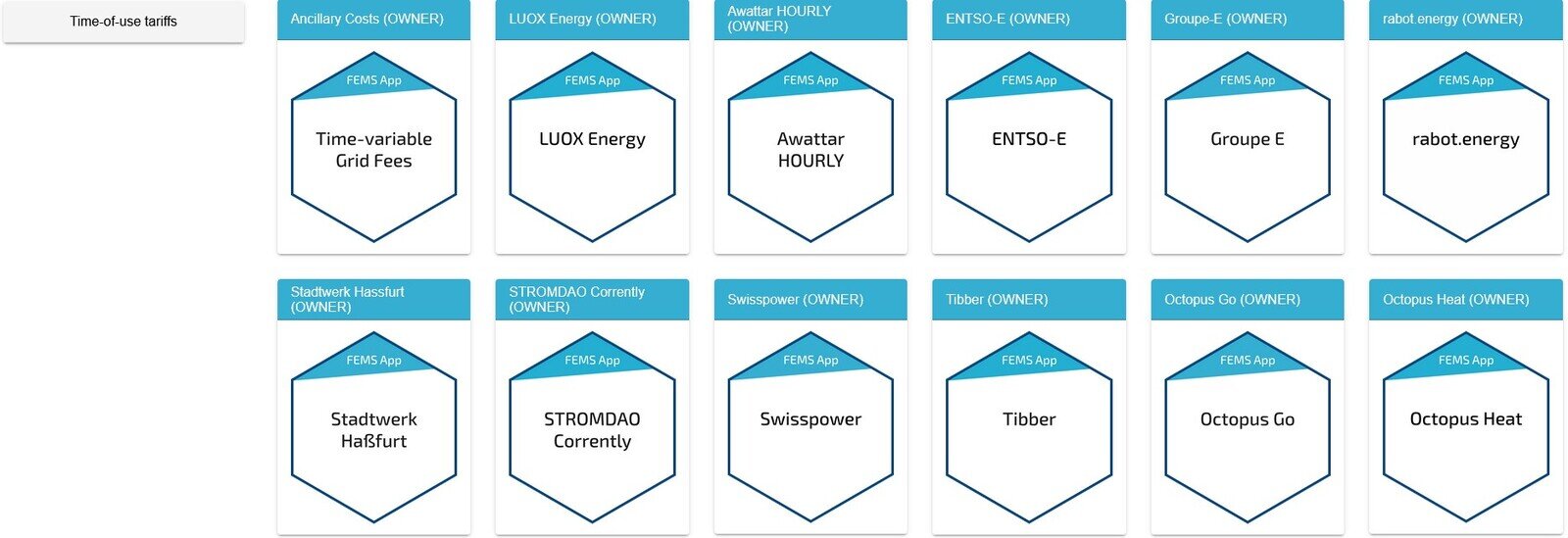
2.1. Time-variable grid charges and FEMS App Time-of-Use Tariff — ENTSO-E
|
When using time-variable grid charges in conjunction with Time-of-Use tariffs, the checkbox Use Time-of-use tariffs according to § 14a EnWG (Module 3)? must be checked when installing the ENTSO-E app: |

In the next step, select the Grid operator. If this is not listed, please select Other.

The grid operator’s prices can now be entered on a quarterly basis:
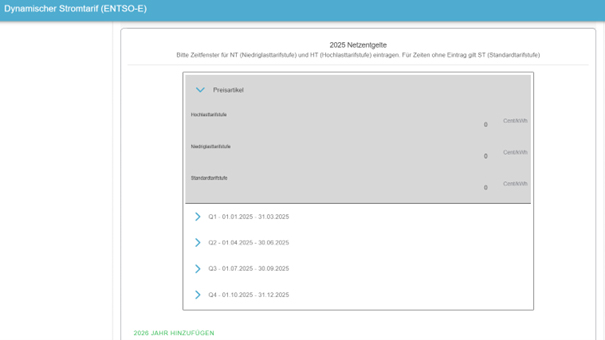
|
When using the ENTSO-E app, the spot market electricity prices are always used. |
3. FEMS App Time-of-Use Tariff
3.1. Why a dynamic electricity tariff?
Previously, the rule was that the electricity price per kilowatt hour (kWh) was fixed statically for at least a whole year. However, electricity is actually traded on the exchange e. g. in 15-minute units for the next day ("day-ahead"). These 15-minute electricity exchange prices reflect the variability of an energy system based on renewable, volatile wind and solar energy. Electricity is always particularly cheap on the exchange when the sun is shining, the wind is blowing or consumption is low. The dynamic electricity tariff is therefore always closer to reality than a tariff set statically by the energy supplier1. For us as a society, this ideally results in a win-win situation: end customers can benefit from favorable prices if they can flexibly shift their grid consumption over time. Grid operators can distribute the load on the grids more evenly by using variable prices. This is another reason why the legislator is obliging all energy suppliers in Germany to offer dynamic electricity tariffs from January 2025.
*1 A favorable exchange price is not always beneficial to the grid; on the contrary, it can even lead to expensive redispatch costs. The regulatory authorities are actively working on these issues. For example, there are discussions about making grid fees variable in order to reflect the varying utilization of the grid over time.
3.2. Advantages of the "FEMS App Time-of-Use Tariff"
-
Fully-automatic operation
After initial commissioning, the app works completely automatically and selects an optimized operating mode in each case; no parameterization of threshold value electricity prices etc. is necessary.
-
You retain your independence
You are free to choose your electricity provider at any time. On the cut-off date, simply uninstall the previous app and install the app for your new provider free of charge.
-
One-time purchase, no recurring costs
After the one-time purchase, there are no recurring, e. g. monthly, costs for the app — including free, lifelong updates.
-
OpenEMS Community
The software is being developed further in cooperation with universities, institutes and other manufacturers of energy management systems in the global OpenEMS community.
-
Energy Journey
We are already thinking about the next steps in your personal Energy Journey. That is why many further developments are being planned, e. g. price-based optimization of controllable consumer loads such as EVs and heat pumps, consideration of planned power dimming in accordance with § 14a EnWG, participation in intraday trading, compatibility for other countries and BESS products, etc.
3.3. Compatible with all energy suppliers
The "FEMS App Time-of-Use Tariff" is compatible with all energy suppliers:
-
-
Compatibility:
Country \ System
FENECON Home 10
FENECON Home 6, 10 & 15
FENECON Home 20 & 30
FENECON Commercial 92
FENECON Industrial S
FENECON Industrial L
Germany
-
-
-
Hier gelangen Sie zur Installationsanleitung der FEMS App Time-of-Use Tariff in Verbindung mit LUOX Energy.
-
Compatibility:
Country \ System
FENECON Home 10
FENECON Home 6, 10 & 15
FENECON Home 20 & 30
FENECON Commercial 92
FENECON Industrial S
FENECON Industrial L
Germany
-
-
-
Thanks to the direct integration of the Tibber price interface, the app can use the actual end customer prices.
-
During installation, you will need a personal access token for your Tibber account. You can create this at https://developer.tibber.com/settings/access-token.
-
Compatibility:
-
-
Country \ System |
FENECON Home 10 |
FENECON Home 6, 10 & 15 |
FENECON Home 20 & 30 |
FENECON Commercial 92 |
FENECON Industrial S |
FENECON Industrial L |
|---|---|---|---|---|---|---|
Germany |
||||||
Netherlands |
||||||
Sweden |
-
-
aWATTar was one of the first providers of a dynamic electricity tariff in Germany and Austria.
-
Compatibility:
-
Country \ System |
FENECON Home 10 |
FENECON Home 6, 10 & 15 |
FENECON Home 20 & 30 |
FENECON Commercial 92 |
FENECON Industrial S |
FENECON Industrial L |
|---|---|---|---|---|---|---|
Germany |
||||||
Austria |
-
-
STROMDAO Corrently pursues an innovative, grid-friendly approach that uses regional electricity generation and consumption to calculate a "green electricity index". This is used for optimization in the app instead of a price per kWh.
-
During installation, simply enter your zip code.
-
Compatibility:
-
Country \ System |
FENECON Home 10 |
FENECON Home 6, 10 & 15 |
FENECON Home 20 & 30 |
FENECON Commercial 92 |
FENECON Industrial S |
FENECON Industrial L |
|---|---|---|---|---|---|---|
Germany |
-
-
Octopus Go offers a lower working price between 00:00 and 05:00 h, which is individual to the customer.
-
When installing the app, the standard price and low price must be entered once.
-
Compatibility:
-
Country \ System |
FENECON Home 10 |
FENECON Home 6, 10 & 15 |
FENECON Home 20 & 30 |
FENECON Commercial 92 |
FENECON Industrial S |
FENECON Industrial L |
|---|---|---|---|---|---|---|
Germany |
-
-
Octopus Heat offers a low working price for 8 hours a day, customized for the customer.
-
There is a higher working price for 3 hours.
-
Standard, low and high prices must be entered once when installing the app.
-
Compatibility:
-
Country \ System |
FENECON Home 10 |
FENECON Home 6, 10 & 15 |
FENECON Home 20 & 30 |
FENECON Commercial 92 |
FENECON Industrial S |
FENECON Industrial L |
|---|---|---|---|---|---|---|
Germany |
-
-
Compatibility:
-
Country \ System |
FENECON Home 10 |
FENECON Home 6, 10 & 15 |
FENECON Home 20 & 30 |
FENECON Commercial 92 |
FENECON Industrial S |
FENECON Industrial L |
|---|---|---|---|---|---|---|
Germany |
| The FEMS App Oststrom is currently still under development. Please use ENTSO-E instead. |
-
-
In the Stadtwerks Haßfurt grid area, you can choose between "haStrom Flex with price limit" and "haStrom Flex Pro without price limit".
-
Compatibility:
-
Country \ System |
FENECON Home 10 |
FENECON Home 6, 10 & 15 |
FENECON Home 20 & 30 |
FENECON Commercial 92 |
FENECON Industrial S |
FENECON Industrial L |
|---|---|---|---|---|---|---|
Germany |
-
-
Compatibility:
-
Country \ System |
FENECON Home 10 |
FENECON Home 6, 10 & 15 |
FENECON Home 20 & 30 |
FENECON Commercial 92 |
FENECON Industrial S |
FENECON Industrial L |
|---|---|---|---|---|---|---|
Switzerland |
-
Exchange electricity price — ENTSO-E
-
Most energy suppliers currently still pass on the day-ahead prices of the electricity exchange 1-to-1 in their dynamic electricity tariffs. The energy management system receives these prices directly from the European electricity platform ENTSO-E and is therefore compatible with all energy suppliers. Please note that ancillary electricity costs (grid charges, etc.) cannot be taken into account.
-
One of the following price bidding zones can be selected during installation: Germany, Austria, Sweden (1, 2, 3 or 4) and the Netherlands
-
Compatibility:
Country \ System
FENECON Home 10
FENECON Home 6, 10 & 15
FENECON Home 20 & 30
FENECON Commercial 92
FENECON Industrial S
FENECON Industrial L
Germany
Austria
Netherlands
Sweden
-
3.4. Functionality
The "FEMS App Time-of-Use Tariff" consists of:
-
a specific section that is used to read in the individual dynamic electricity prices depending on the energy supplier or electricity tariff. The prices are usually made available from 2 p.m. in quarter-hourly or hourly resolution until the end of the next day.
-
the visualization and configuration view, the control algorithm, etc., which are uniform for all tariffs.
The control algorithm runs through the following steps:
-
Forecast of local generation and consumption based on historical data
-
Artificial intelligence links these forecasts with the dynamic electricity prices and determines an optimized energy plan. This defines an operating mode for every quarter of an hour of the available period:
-
Self-consumption optimization: The electrical energy storage system operates in normal self-consumption optimization mode. Consumer loads are supplied from the PV system and battery if possible. If this is not sufficient, the remaining energy is drawn from the grid.
-
Delayed discharge: Instead of supplying consumer loads from the battery, discharging is delayed — with the aim of reserving already stored energy for times when prices are higher.
-
Release charging from the grid: The battery is actively charging from the grid in order to use the charged energy to supply the predicted consumption during significantly more expensive times. (Only available if "Active charging from the grid" has been activated).
-
-
These steps are repeated every quarter of an hour in order to continuously adapt the energy plan to changing framework conditions (e. g. if actual generation/consumption deviates from the forecast).
-
In real-time control, the control algorithm always applies the mode planned for the current quarter of an hour.
|
Um die optimale Funktionsweise zu garantieren, müssen alle externen Erzeuger ins FEMS eingebunden werden. |
3.5. Visualization and configuration in Online Monitoring
After installing the "FEMS App Time-of-Use Tariff", you will see the following widget in your live monitoring:
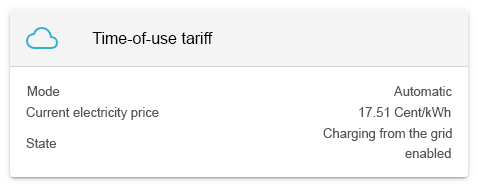
Click on the widget to open the detailed and configuration view:
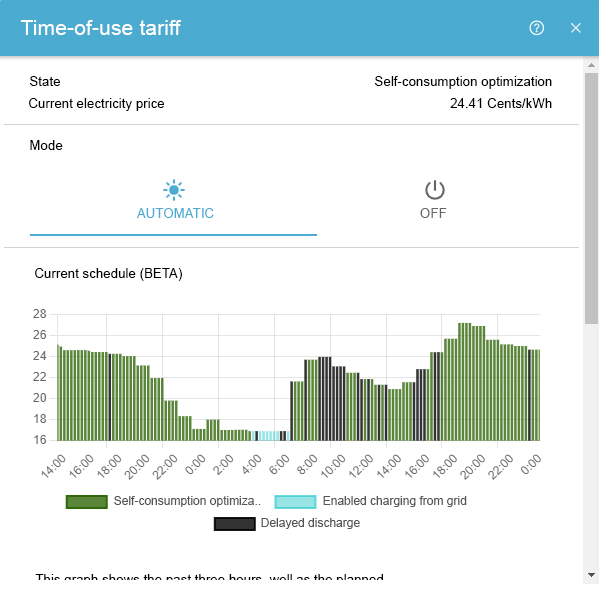
Select the mode of the app here:
-
OFF
This mode deactivates optimization according to a dynamic electricity tariff. Prices are still recorded, but the electrical energy storage system works permanently in self-consumption optimization.
-
AUTOMATIC
This mode activates automatic optimization. Optionally, the "Active charging from the grid" function can be activated.
The history shows the recorded data for "FEMS App Time-of-Use Tariff" in the selected time period:

Clicking on the widget also opens the detailed view here. This shows:
-
State of Charge
the State of Charge of the electrical energy storage as a percentage [%]
-
Self-consumption optimization
Time periods in "self-consumption optimization" mode
-
Discharge delayed
Time periods in "Delayed discharge" mode
-
Release charging from the grid
Time periods in "Release charging from the grid" mode (only available if "Active charging from the grid" has been activated).
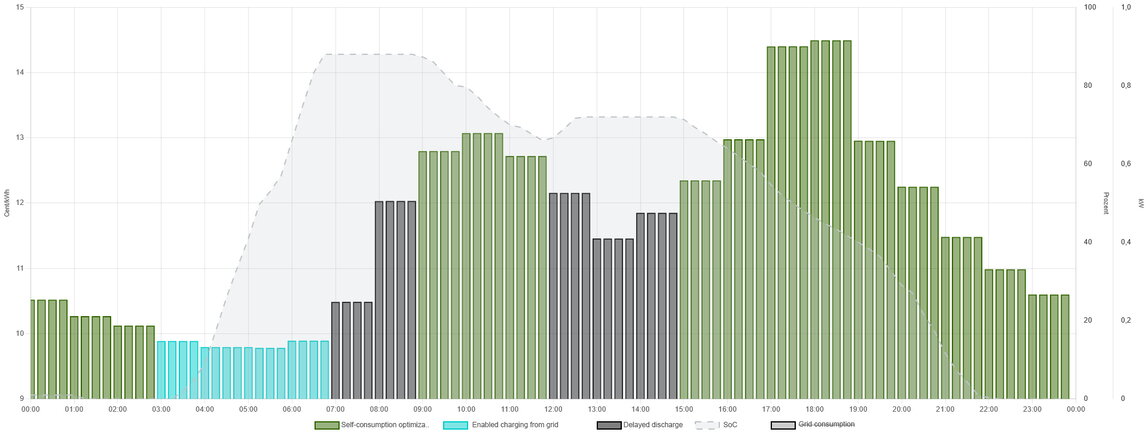
The graph shows a day with an automatic energy plan. The height of the bars shows the electricity price per quarter of an hour or hour.
-
In the morning, the battery is initially empty. From 3 a.m., the blue bars show that the battery is actively charging from the grid and the state of charge — the dashed line — is increasing.
-
From 7 a.m. to 9 a.m., prices are average, so the AI decides to supply consumption from the grid during this time. The app works in "delayed discharge" mode and the state of charge remains constant.
-
During the high-price phases from 9 a.m. to 12 p.m. and from 3 p.m., the electrical energy storage system supplies all consumer loads and there is no draw on the grid — until the battery is empty again in the evening.
3.6. Limiting the maximum amount of electricity drawn from the grid
To change the limit on the maximum amount of electricity drawn from the grid into the electrical energy storage system, please proceed as follows.
Using the example of ENTSO-E:
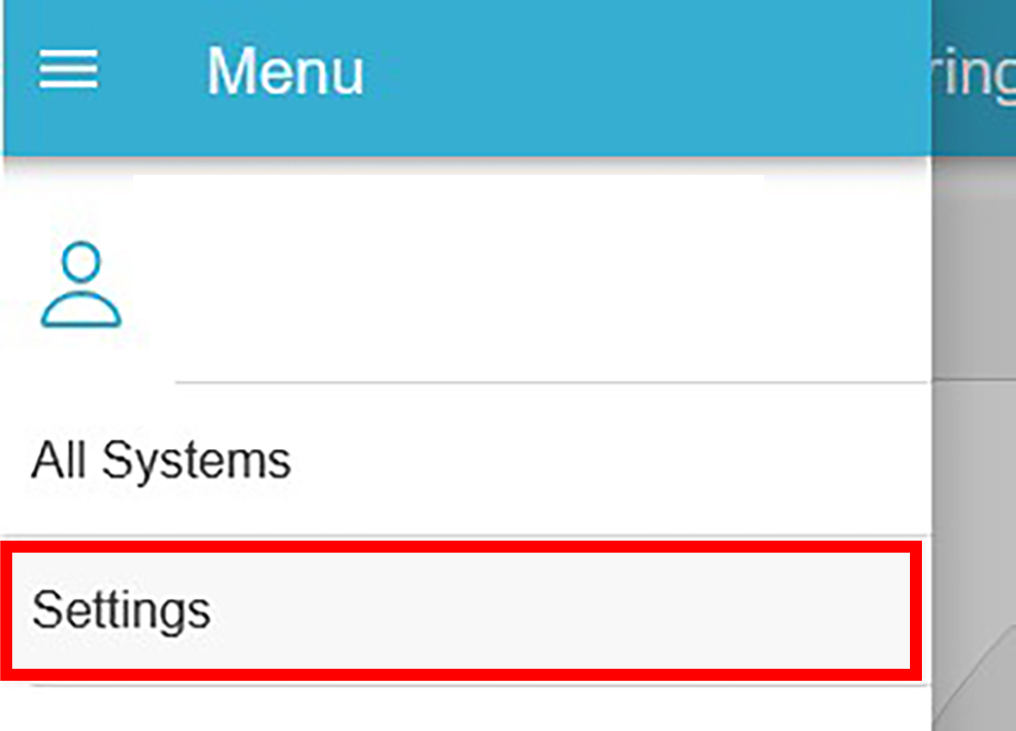
|
|

|
|
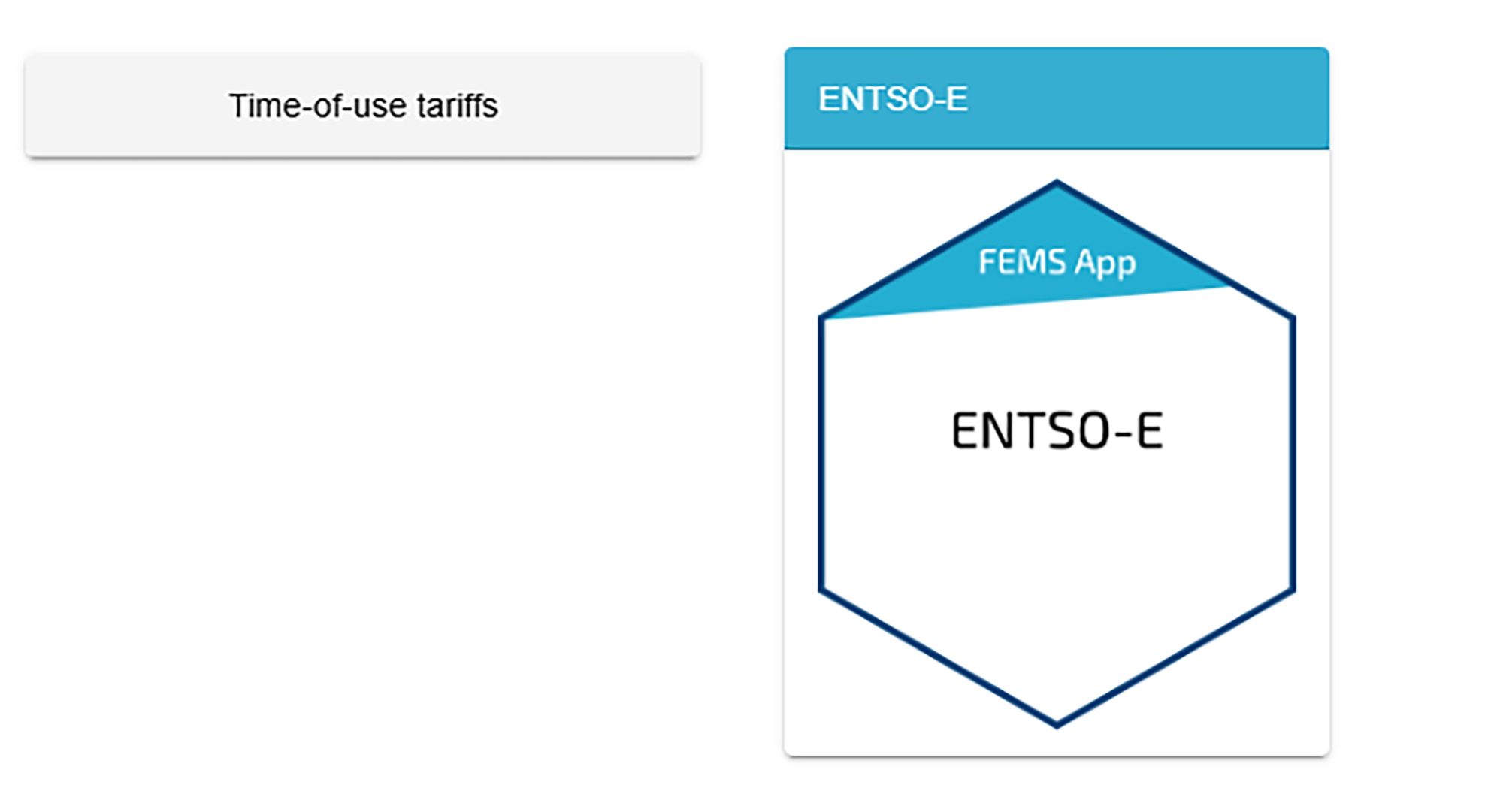
|
|
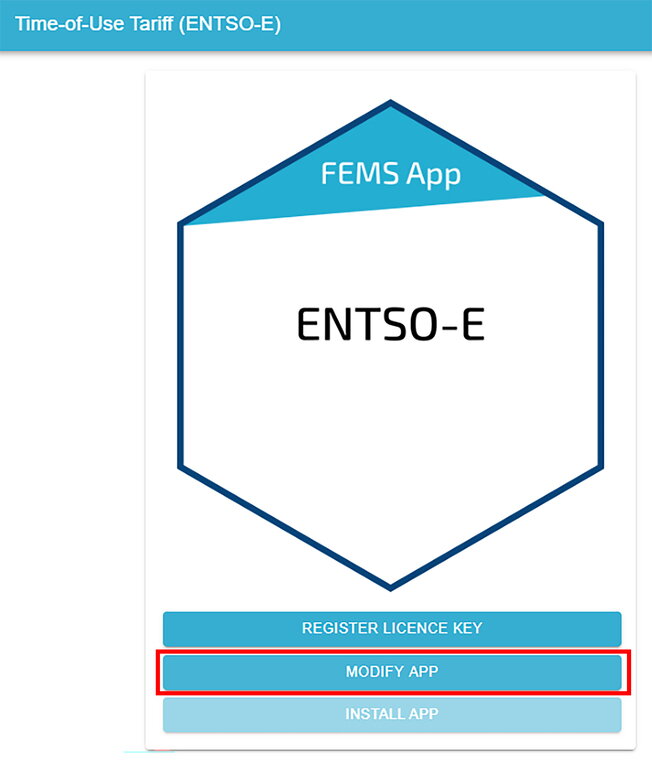
|
|
This settings window appears:

The Maximum grid withdrawal can now be set here by battery charging.
|
The value must not be set higher than the dimensioning of the corresponding miniature circuit breakers in the household. |
3.7. FAQ & Troubleshooting
-
What is FEMS App Time-of-Use Tariff?
"FEMS App Time-of-Use Tariff" enables active charging of the battery from the grid in times of low electricity prices. "Charging from the grid" was publicly launched on 15 November 2023. Since then, users of the "FEMS App Time-of-Use Tariff" have been able to choose to activate "Active charging from the grid".
During the BETA test, we received a lot of feedback from interested customers who shared their experiences with us.
ATTENTION: Active charging of the battery from the grid beyond the technically necessary trickle charge requires a corresponding registration of the storage system. If in doubt, please contact your installer. By pressing the blue "Save" button, you confirm that you have carried out this check.
Please note: To be eligible for a subsidy under the Renewable Energy Sources Act (EEG), the electrical energy storage system must only temporarily store electricity generated from renewable energy sources and/or pit gas. When this function is activated, the electrical energy storage system is charged with grid electricity. Depending on the electricity supply contract, this grid electricity may also be generated from fossil fuels and/or nuclear power. Therefore, we cannot guarantee that the electrical energy storage system will only be charged with electricity from renewable energy sources and/or pit gas.
-
Was the test successful?
Yes, we have already been able to significantly improve the algorithms thanks to the many different system configurations (battery capacities, size of the PV system, consumer loads such as EVs, heat pumps and infrared heaters, etc.).
-
How does the BETA test continue?
Every user of "FEMS App Time-of-Use Tariff" can still decide whether they want to activate the "Active charging from the grid" function. The BETA test will continue indefinitely for the time being in order to fine-tune the behaviour in spring, summer and autumn, as well as in conjunction with other apps such as Grid-Optimized Charging.
-
For which customers is the "FEMS App Time-of-Use Tariff" interesting?
Our evaluations show that in December 2023 alone, shortly after the start of the BETA test, most customers were able to achieve savings of €10 to €40 per system with the "FEMS App Time-of-Use Tariff", depending on the storage size and consumption profile.
As dynamic tariffs are also generally cheaper overall than classic fixed-price electricity tariffs, most customers saved between €40 and €140 in December (comparative value: gross electricity price of 32 cents/kWh).
-
Which other dynamic electricity plans are still being integrated?
Our aim is to give the user of the "FEMS App Time-of-Use Tariff" full independence. Our goal is therefore to support all 1150 electricity plans that will be available in Germany from January 2025. However, this will take very different forms.
If the tariff offers no further added value for the end customer and only tracks the fluctuations on the exchange, we will prefer to map it via the ENTSO-E platform.
Here you will find a list of our currently compatible energy suppliers.
-
Why are there not more manual intervention options (e. g. "Charging at prices below a threshold value")?
The development goal of the "FEMS App Time-of-Use Tariff" is a largely fully automatic mode of operation that optimizes the electricity procurement costs for consumption that cannot be covered by a local photovoltaic system. Efficiency losses at various points in the system are taken into account.
We are using the experience gained in the BETA test with different system configurations, generation and consumption profiles in different seasons to derive and test further automatic optimizations (e. g. efficient charging of the battery only from a DC-connected PV system).
Manual intervention options such as a price threshold often fall short at this point, contradict the development objective or make analysis and development work more difficult.
-
With which FENECON storage systems is the "FEMS App Time-of-Use Tariff" compatible?
The app is currently only compatible with FENECON storage systems.
Other systems, such as the FENECON Pro Hybrid 10, are unfortunately permanently excluded from compatibility.
-
Is a permanent internet connection required?
Yes, our storage systems also work without a permanent internet connection. However, a permanent Internet connection is absolutely necessary for the "FEMS App Time-of-Use Tariff" in order to read in the prices from the energy supplier.
-
What power is used to charge the electrical energy storage in "Release charging from the grid" mode?
The charging power is calculated adaptively in relation to the available capacity and predicted consumption.
-
The behavior of the "FEMS App Time-of-Use Tariff" is not comprehensible or illogical.
For various reasons, the behavior of the "FEMS App Time-of-Use Tariff" sometimes appears illogical. Since the app depends on the quality of the consumption and generation forecasts, there is always a certain inherent "fuzziness" in the behavior that can appear illogical in retrospect.
However, such behavior can usually be traced back to one of the following problems:
-
Full coverage of local generation
The consumption and generation forecast is based on local historical data. It is therefore essential that generators are recorded without any gaps. Regular substantial 'negative consumption' in the historical view is an indication of such an error.
-
EV charging
Even if the current version of "FEMS App Time-of-Use Tariff" does not yet actively control EV charging, the measurement data from compatible EV charging stations is already processed in the consumption forecast. We therefore recommend using a compatible charging station and purchasing the corresponding app.
-
Time for self-programming
The local consumption and generation forecast requires at least 24 hours for self-programming.
-
Restart or system update
After a restart or a system update, the AI algorithm needs some time to determine an optimal energy plan. During this time, the app works in "self-consumption optimization" mode.
-
No charging at the lowest price
The "FEMS App Time-of-Use Tariff" takes into account efficiency losses that occur when charging and discharging the battery from the grid. Charging is only carried out if the price difference over the course of the day justifies it.
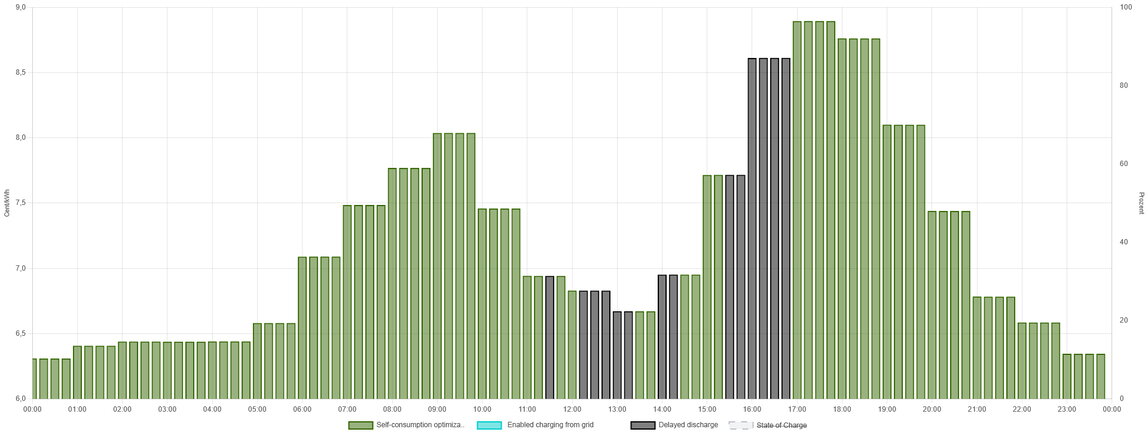 Figure 9. No charging at the lowest price
Figure 9. No charging at the lowest priceThe screenshot shows a corresponding daily curve. The price peak in the afternoon can be bridged by surplus PV generation and delayed discharging. This means that only the hours with a low price in the early morning would be suitable for charging from the grid. In this case, however, the price difference is too small (approx. 6.5 cents/kWh at night and 8.0 cents/kWh in the morning), so charging is not carried out.
-
Fully charge electrical energy storage from the grid
For minimizing forecast errors, the app stops in "Release charging from the grid" mode when the State of Charge reaches 90 %.
-
3.8. Further information
-
We develop the algorithms and connections used in the "FEMS App Time-of-Use Tariff" in cooperation with universities, institutes and other manufacturers of energy management systems in the global OpenEMS community.
-
Find more information about OpenEMS at www.openems.io
-
If you are interested, please feel free to contribute to the discussion in the OpenEMS Community
-
-
Detailed background information on exchange electricity prices can be found at Energy-Charts.info